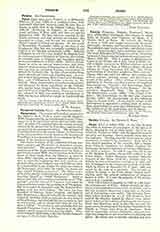

Peregrinus. —The canons of Priscillian, prefixed to the Epistles of St. Paul in many (chiefly Spanish) MSS., are preceded by an introduction headed “Prooemium sancti Peregrini episcopi in epistolas Pauli Apostoli”, in which it is explained that the canons were not written by St. Jerome but by Priscillian, and that they are given in an expurgated edition. The prologue of Priscillian himself to his canons follows; it shows none of the characteristics of style found in the tractates of Priscillian; it has presumably been rewritten by Peregrinus, if the tractates are genuine.
The Codex Gothicus of the cathedral of Leon contains a prayer, and the words “et Peregrini f. o karissimi memento”. The preface of St. Jerome to his lost translation of the Books of Solomon from the Septuagint occurs in some MSS. after his preface to his translation of. those books from the Hebrew; in most of these MSS. (Spanish, or under Spanish influence) a note is appended explaining that both prefaces are given because, to the Vulgate text which follows, there have been added in the margin the additions found in the Septuagint; then come the words “et idcirco qui legis semper Peregrini memento”. The Stowe codex of St. John also has a subscription, in which the writer describes himself as “Sonid Peregrinus”. Sonid is said to be Celtic for a warrior; it reminds us of “Vincentius”, and St. Vincent of Lerins in fact wrote his Commonitorium under the pseudonym of Peregrinus. But he cannot be identified with the Spanish Peregrinus, as he was not a bishop. The latter has been identified by Schepss, Berger, Fritsche, and Künstle with Bachiarius, a Spaniard who left his country, and is fond of speaking of his peregrinatio; he was accused of Priscillianism, and defended his own orthodoxy; but he was a monk, and we do not know that he ever became a bishop. It is however most probable that the Spanish Peregrinus lived at the beginning of the fifth century, and he cannot be later than the eighth. Künstle is wrong in attributing to him the Pseudo-Jerome’s prologue to the Catholic Epistles.
JOHN CHAPMAN

